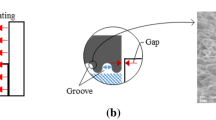Abstract
This report describes a simple and controllable fabrication method of producing superhydrophobic polymer surfaces replicated from aluminum mold inserts in a thermal nanoimprint prepared using precision tooling and an anodized aluminum oxidation process. This producible fabrication method is applicable in the polymer manufacturing field. Patterned hierarchical polymer structures achieved a contact angle greater than 150° without additional coatings. The contact angles were controlled by changing the nanorod length and area fraction of micro-sized convex. Additionally, patterned polymer structures exhibited droplet evaporation behaviors, which show the hysteresis of the solid surface. The hierarchical polymer structures show lower hysteresis than that of microstructures or nanostructures because of the short continuous contact line of nanoscale three-phase contact line and the large area of the micrometer air pocket.





Similar content being viewed by others
References
Bhushan B (2009) Biomimetics: lessons from nature—an overview. Philos Trans R Soc A 367:1445–1486
Cassie ABD, Baxter S (1944) Wettability of porous surfaces. Trans Faraday Soc 40:546
Chu DH, Nemoto A, Ito H (2014) Effects of geometric parameters for the superhydrophobicity with the polymer surfaces fabricated by precision tooling machine. Microsyst Technol 20(2):193–200
Cortese B, D’Amone S, Manca M, Viola I, Cingolani R, Gigli G (2008) Superhydrophobicity due to the hierarchical scale roughness of PDMS surfaces. Langmuir 24(6):2712–2718
Cui Y, Paxson AT, Smyth KM, Varanasi KK (2012) Hierarchical polymeric textures via solvent-induced phase transformation: a single-step production of large-area superhydrophobic surfaces. Colloids Surf A 394:8–13
Deng X, Mammen L, Butt HJ, Vollmer D (2012) Candle soot as a template for a transparent robust superamphiphobic coating. Science 335(6064):67–70
Feng L, Zhang Y, Xi J, Zhu Y, Wang N, Xia F, Jiang L (2008) Petal effect: a superhydrophobic state with high adhesive force. Langmuir 24(8):4114–4119
Han W, Wu D, Ming W, Niemantsverdriet H, Thüne PC (2006) Direct catalytic route to superhydrophobic polyethylene films. Langmuir 22(19):7956–7959
Huovinen E, Hirvi J, Suvanto M, Pakkanen TA (2012) Micro–micro hierarchy replacing micro–nano hierarchy: a precisely controlled way to produce wear-resistant superhydrophobic polymer surfaces. Langmuir 28(41):14747–14755
Kako T, Nakajima A, Irie H, Kato Z, Uematsu K, Watanabe T, Hashimoto K (2004) Adhesion and sliding of wet snow on a super-hydrophobic surface with hydrophilic channels. J Mater Sci 39(2):547–555
Kwon YJ, Patankar N, Choi JK, Lee JH (2009) Design of surface hierarchy for extreme hydrophobicity. Langmuir 25(11):6129–6136
Lee SM, Kwon TH (2007) Effects of intrinsic hydrophobicity on wettability of polymer replicas of a superhydrophobic lotus leaf. J Micromech Microeng 17:687–692
Lee W, Jin MK, Yoo WC, Lee JK (2004) Nanostructuring of a polymeric substrate with well-defined nanometer-scale topography and tailored surface wettability. Langmuir 20(18):7665–7669
Li AP, Müller F, Birner A, Nielsch K, Gösele U (1998) Hexagonal pore arrays with a 50–420 nm interpore distance formed by self-organization in anodic alumina. J Appl Phys 84(11):6023–6026
Masuda H, Yamada H, Satoh M, Asoh H, Nakao M, Tamamura T (1997) Highly ordered nanochannel-array architecture in anodic alumina. Appl Phys Lett 71(19):2770–2772
Saarikoski I, Suvanto M, Pakkanen TA (2009) Modification of polycarbonate surface properties by nano-, micro-, and hierarchical micro–nanostructuring. Appl Surf Sci 255(22):9000–9005
Saarikoski I, Joki-Korpela F, Suvanto M, Pakkanen TT, Pakkanen TA (2012) Superhydrophobic elastomer surfaces with nanostructured micronails. Surf Sci 606(2):91–98
Soolaman DM, Yu H (2005) Water microdroplets on molecularly tailored surfaces: correlation between wetting hysteresis and evaporation mode switching. J Phys Chem B 109(38):17967–17973
Sun M, Luo C, Xu L, Ji H, Ouyang Q, Yu D, Chen Y (2005) Nonspherical colloidal crystals fabricated by the thermal pressing of colloidal crystal chips. Langmuir 21(19):8978–8991
Xue CH, Jia ST, Zhang J, Ma JZ (2010) Large-area fabrication of superhydrophobic surfaces for practical applications: an overview. Sci Technol Adv Mater 11:1–15
Zhang C, Zhu X, Zhou L (2011) Morphology tunable pinning force and evaporation modes of water droplets on PDMS spherical cap micron arrays. Chem Phys Lett 508:134–138
Zhu K, Vinzant TB, Neale NR, Frank AJ (2007) Removing structural disorder from oriented TiO2 nanotube arrays: reducing the dimensionality of transport and recombination in dye-sensitized solar cells. Nano Lett 7(12):3739–3746
Acknowledgments
This research was financially supported by Cheil Industries Inc., Korea.
Author information
Authors and Affiliations
Corresponding author
Rights and permissions
About this article
Cite this article
Chu, D., Nemoto, A. & Ito, H. Biomimetic superhydrophobic polymer surfaces by replication of hierarchical structures fabricated using precision tooling machine and anodized aluminum oxidation. Microsyst Technol 21, 123–130 (2015). https://doi.org/10.1007/s00542-014-2152-5
Received:
Accepted:
Published:
Issue Date:
DOI: https://doi.org/10.1007/s00542-014-2152-5



